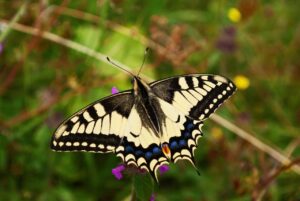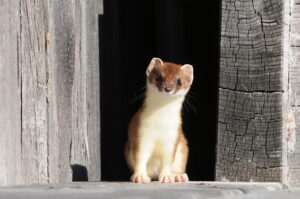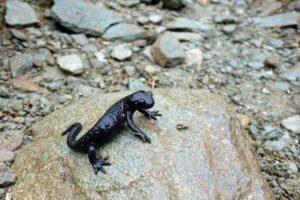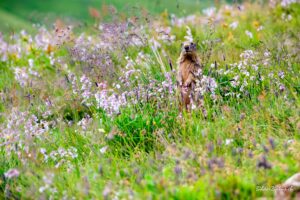Wild life
No neighbors? Well, that's not exactly true...
Around the Arflina there is a lot of wildlife to observe in summer. In addition to marmots and birds of prey, red deer can be observed very close to the Glattwang early in the morning. It is not uncommon to see over a hundred red deer in one place.
Also on the Glattwang, chamois can be found on the rocky flanks of the mountain range. With a bit of luck and depending on the wind, the chamois and their young can be observed up close.
«Der Tourist zerstört, was er sucht, indem er es findet», Hans Magnus Enzensberger.
Wir möchten zeigen, dass sich ein sanfter Tourismus und eine intakte Tierwelt nicht ausschliessen. Daher bitten wir Euch, Eure Sinne zu schärfen, Wildtiere aus der Distanz zu beobachten, bei Beobachtungen leise zu sein und die Tier- und Pflanzenwelt abseits der Wanderwege um die Gipfel nicht zu stören. Dann erschliesst sich aufmerksamen Gästen eine Gegend mit unvergesslichen Begegnungen.
Mit etwas Glück und Geduld könnt Ihr bei Eurem Ausflug in Heuberge folgende Bewohner beobachten:

The king
The golden eagle soars majestically over the peaks of Glattwang and Mattjischhorn. Mighty is its appearance with a wingspan of about two meters. When it soars over the peaks, it is time for marmots and chamois to retreat so as not to become prey to the king of the skies. Those who look attentively into the sky in summer can sometimes even marvel at the golden eagle from the terrace of the Berghaus Arflina as it circles the Glattwang.

The top dog
You can hear them from afar in autumn, the imposing red deer with the largest antlers of all deer, which vie for the favor of the females behind the Glattwang. The females, which do not wear antlers themselves, give birth to their calves in June. Early in the morning in summer and in autumn, with a little luck, up to more than 100 red deer can be observed in the game sanctuary on the Glattwang. In the Wildasyl the red deer find cool places in summer and protection from hunting in autumn.

The skillful
With their capers over rock and stone, they amaze many hikers and make children laugh. They feed on the herbs and shrubs of our mountain peaks. The chamois likes to raise its young on the Glattwang, where they move safely over hill and dale after only a few hours after birth and impress us with their balancing skills.

The magnificent
Colorful they move over the wildflowers of the meadows and peaks around the Heuberge. Numerous butterflies, which have become rare in the meantime, find their home in the species-rich flora of the Heuberge. The meadows around the Heuberge, which are carefully tended by our farmers, are only mowed every second year so that the diversity of plants is preserved for future generations of butterflies.

The stealthy
Eerily well camouflaged is our secret neighbor, because its fur adapts to the seasons. It moves skilfully between the wood of the stables and the maypens, where it has done good service in the fight against mice over the past centuries. Just when you spot it, it scurries by, the 10 centimeter small ermine.

The durable
It is excellently adapted to the challenging climate at 2000 meters. It can live up to 20 years and the pregnancy of this only about 10 cm small animal can last up to 4 years. The alpine salamander, which is black all over, protects itself with a mucous membrane that is poisonous to predators and likes to stay on damp paths along the alpine peaks.

The shy
They are rarely seen because their plumage camouflages them well in the rocky areas around our peaks. Like the stoat, the rock ptarmigan adapt their dress according to the seasons, changing their plumage from gray in summer to white in winter. They are usually only discovered by chance along the hiking trails, when they are moving or making sounds that sound a bit strange.

The attentive
Nothing escapes them, they curiously peek from the safe cave entrance onto the plains of the Clune lakes and look down on the visitors of the hay mountains. Only when you get close to them do they warn each other with a whistle and disappear in a flash into their family burrow. But the marmots are not afraid of humans. They have already been sighted in our skiing areas or digging at the foundations of the Maiensässe. But they fear the king of the air, because they are on his menu.

The Others
Besides all these animals, there are numerous other mammals, insects, birds, amphibians and reptiles around the haymaking hills. At the end of winter, when we are in the mid-season, the black grouse are mating on and off the slopes. The fox visits us regularly, not always to our delight, because he likes to steal shoes or food. Not only the fox and the hare say good night to each other, but also countless frogs and grasshoppers love the surroundings of the hayfields.
Also the flora is remarkable
The Heuberge mountains are a paradise for plant lovers. And the summer meadows around the Heuberge promise a diversity of species that is second to none. So that hikers and plant lovers can find out about the fauna typical of the region, there is a plant nature trail very close to the Arflina, which is maintained by volunteers from the village of Fideris. Guided tours of the plant trail by local specialists are also possible.
Neighbouring nature
Biodiversity in the Heuberge mountains








